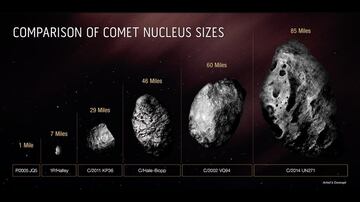When will the ‘comet of the century’ C/2023 A3 pass by Earth?
C/2023 A3 has been dubbed a potential “comet of the century” because it’s expected to grow a beautiful cometary tail that will be visible to the naked eye.

According to Canadian astronomer and comet discoverer David H. Levy, Comet C/2023 A3 (Tsuchinshan-ATLAS), discovered in 2023, will be the “comet of the century.” One of the characteristics that differentiates this from many others is the cometary tail that it is expected leave behind, set to be more prominent than usual.
This phenomenon is due to the fact that after passing the Sun, the dust and ice of this comet will heat up noticeably, causing the ice particles to evaporate and escape quickly into space, transporting with them a large amount of dust that will spread.
Another feature that makes this comet special is its brightness, which will vary depending on its activity during the coming months. Despite this unpredictability, most researchers believe that it is possible that “the comet of the century” will be visible to the naked eye. With some luck, it could even surpass the brilliance of the C/2020 F3 (NEOWISE) of summer 2020.
This comet can also be seen from the Northern Hemisphere, which is something unusual, since the last time an exceptionally bright comet could be visible from these latitudes was in 1997, with the arrival of Comet Hale- Bopp. One of the reasons behind C/2023 A3′s brightness is the size of its core, which is larger than average, with a diameter of between six and 15 kilometers according to some estimates.
READ ALSO: The threat posed to the US power grid by extreme heat

How was C/2023 A3, the ‘comet of the century’, discovered?
The comet’s discovery took place in South Africa on February 22, 2023, when the ATLAS telescope detected a new object that would later be proven to be a comet. It was initially named A10SVYR.
It was also captured by the Purple Mountain Observatory telescope on January 9, 2023. Although it was added to the list of objects awaiting confirmation, it was temporarily classified as lost on January 30, 2023. However, shortly after, observations were made again in the Minor Planet Center archives, returning the heavenly body to the spotlight.
READ ALSO: California and the South-West to be subjected to this extreme heat
What application lets you track C/2003 A3, the ‘comet of the century?’
In order to check the location of C/2003 A3 you will only need to download the Sky Tonight application. After downloading, open the app and press the magnifying glass icon; then write “A10SVYR” in the search engine and press the white icon.
When these steps are carried out, the application will show the current location of the comet in the sky. Simply raise the phone and point it towards the sky and follow the white arrow to see its location.
Is the ‘comet of the century’ visible now?
Yes, it can currently be seen, although its light is still quite dim, with a magnitude of approximately 10. The best time slot to view it is late afternoon in the northern and southern latitudes. One way to see this comet more clearly is through telescopes, even small ones. It is also possible to be captured with a DSLR camera.
It will not be until September, when it passes closer to the sun, when it can be observed with greater visibility. According to the forecast, the months of June, July and August will be the periods where it will be most visible in the southern hemisphere, while from September it will begin to gain greater prominence in the northern hemisphere. The best dates for observation in the northern hemisphere will be from September 27 to October 2.
Where did the name of the comet come from?
The letter C explains that it is a non-periodic comet. This type of comet comes from the Oort cloud and can pass through the Solar System once or take 200 to thousands of years to orbit the Sun.
Meanwhile, 2023 A3 indicates that it was discovered in 2023, specifically in the first half of January (comet nomenclature that corresponds to the letter A). It is the third object of this type discovered in that period.
Finally, Tsuchinshan-ATLAS refers to the telescopes of the Purple Mountain Observatory and the Asteroid Impact Warning System (ATLAS).





